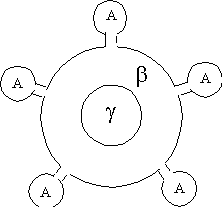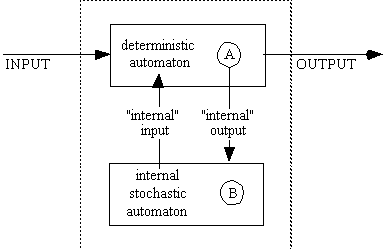In fact automata-pages of class A are useful
and necessary but it is not possible to reduce everything to a
single page. More probably such a page (A) should be joined (Fig. 41)
through some automata of an other
class (beta),and these could have an intro-open
extension (gamma).
Within the class of automata we should also consider the stochastic
and fuzzy automata, the latter being based on fuzzy set
theory29.

Fig. 41
6. A finite automaton m = <X,Y,S,f,g>(1) is
characterized by an input alphabet:
X = {x1,x2,... , xp}(2)
which is a finite, nonempty set of symbols (letters); an outputalphabet,
Y = {y1,y2,... ,yp},(3)
which is also a finite nonempty set of symbols; the set
of states of m,
S = {s1,s2,... ,sn}(4)
also finite and nonempty; a function of state change
f,that makes to every pair
(xi,sj)to correspond a state
sk;by an output function
g, that makes to every pair
(xi,sj)to correspond an output
symbol yi.
The above definition30
needs, in the case of deterministic automata, an univocal description
of functions f and g. If these functions are not univocal defined
then the automaton is not deterministic. If f and/or g are not
defined for all the pairs (xi,sj)
then the automaton is named incomplete. For the purpose we follow
here we are looking for an automaton that contains a deterministic
part (class A) and a stochastic part (class B)*.
If we add to a deterministic automaton an
"internal" stochastic automaton (Fig. 42), then the
functioning of the original deterministic automaton depends both
on the external world and on the internal one. Characteristic
for the internal automaton must be its own autonom pace, i.e.
having its states modify independently of a signal coming or not
from the automaton in contact with the outside world. The internal
pace could be another than the external pace. The purpose of the
internal automaton is that of modifying the state of the automaton
that comes in contact with the outside world, i.e. of the automaton
that provides the immediate behavior.

Fig. 42
Very interesting also appears the incomplete
automaton. If to an input symbol xi
and a state sj
no new output state is defined, nor at least the probability of
the new state and new output, then this fact could be due to our
reduced possibility of specifying in some way the behavior of
the automaton31 or it could be, in the case of certain structures,
one of their intrinsic properties. The second case could present
interest for us, since we could accept a device (Fig. 43) which
for certain pairs (xi,sj)
would create (by reorganizing the automaton) new states and new
outputs, so far unforeseen. That means to produce modifications
in the automaton which will increase (in any case will modify)
the set of states and the output alphabet.

Fig. 43
One of the main efforts of the automata theory
is directed towards finding equivalence classes for automata,
and then of finding the minimum automaton using the concept of
equivalent automata. All the equivalent automata have the same
external behavior, and the minimal automaton has a minimum number
of internal states, hence it can be constructed with a minimum
number of elements. This principle has been followed many years
due to economic reasons.
* It is not necessary to take into account the
nondeterministic automata (that may be non stochastic).
Intro-Open Systems
79








